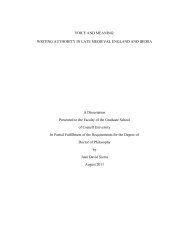CARPET WEAVERS AND WEAVING IN THE ... - Cornell University
CARPET WEAVERS AND WEAVING IN THE ... - Cornell University
CARPET WEAVERS AND WEAVING IN THE ... - Cornell University
You also want an ePaper? Increase the reach of your titles
YUMPU automatically turns print PDFs into web optimized ePapers that Google loves.
less “but not substantially less” than those in poorer households. In the most well-off<br />
households weaving generated one fourth of the income whereas in the poorest it<br />
constituted one-half of the total household income (1986, 186). Her research<br />
demonstrates that paid work as a weaver did not foster gender equality since the labor<br />
fit into the pre-existing cultural framework and men controlled the product of said<br />
labor (Berik 1986, 236).<br />
Women did not have control over whether or not they wove (labor power),<br />
over the product of their labor, their income or the spending of said income, and thus<br />
weaving for pay did not increase their autonomy or enhance their position; weaving<br />
was not so much a “choice” as a “duty” as a woman in the household (Berik 1986,<br />
226), contradicting Gumen’s prediction that weaving for sale would call into question<br />
the linkage between weaving and household responsibilities (Gumen 1987). Women<br />
also did not choose the production system that they worked under (Berik 1986, 229).<br />
Even if women were not able to choose the system of production, numerous types of<br />
production may be present in a single village. This examination of conditions did not,<br />
however, consider the differential effect on women’s lives of weaving in the home<br />
versus weaving outside of the home in regard to aspects other than control of labor and<br />
the product thereof.<br />
Kimberly Hart (2005) also weighed in on these issues. She began her<br />
anthropological research in 1998 in Orselli village in the Yuntdag region of Western<br />
Anatolia. This village is the center of the Yuntdag cooperative of the DOBAG project<br />
and mainly focused on examining women’s lives through the practice of weaving and<br />
the institution of marriage. The Dogal Boya Arastirma ve Gelistirme Projesi<br />
(DOBAG) was established by German scientist Harold Bohmer in 1981 as a means of<br />
reviving natural dye traditions and generating cash income in subsistence-level<br />
agricultural villages in Western Turkey (Anderson 1998, 6). Bohmer’s cooperatives<br />
28

















